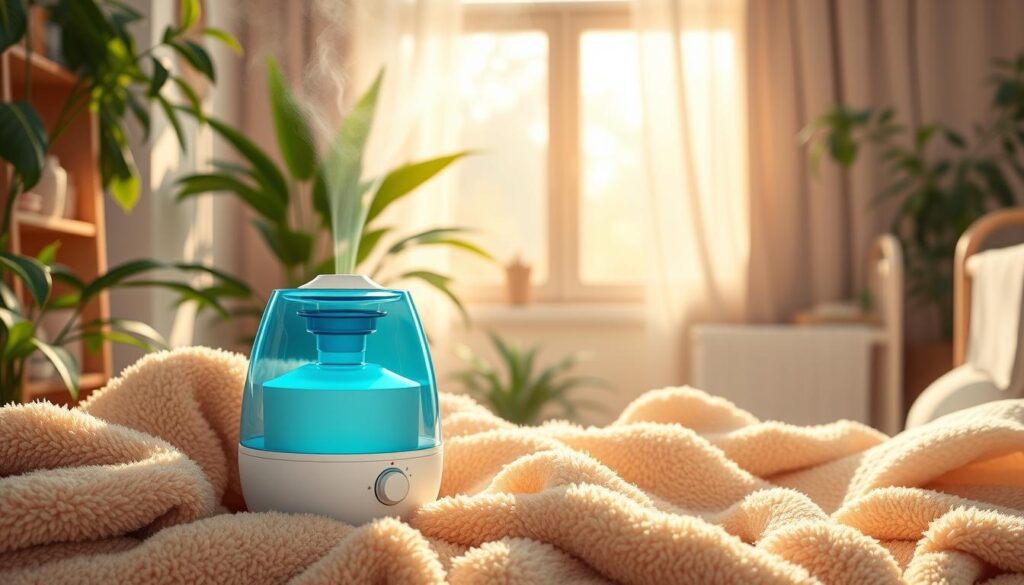How to Prevent Baby’s Dry Skin in Winter
As the winter chill sets in, parents face a significant challenge in protecting their baby’s delicate skin from the harsh elements. Did you know that eczema affects over 30 million Americans and around 10% of the world’s population? This prevalent skin condition can be exacerbated by the drying effects of cold weather, making it crucial for parents to adopt a proactive approach to winter skincare. This comprehensive guide will equip you with the essential strategies to keep your baby’s skin healthy and hydrated throughout the cooler months.
Key Takeaways
- Understand the impact of winter on baby’s skin barrier and the risk factors for winter-related skin problems
- Develop a tailored winter skincare routine with the right moisturizers and bathing practices
- Learn to manage eczema flare-ups and create an eczema-friendly environment
- Explore natural remedies and home solutions to soothe and protect delicate baby skin
- Know when to seek medical attention for severe skin issues
Understanding Winter’s Impact on Baby Skin
As the cold winter winds sweep in, parents may notice concerning changes in their baby’s delicate skin. The harsh conditions of the season can disrupt the skin’s natural baby skin barrier, leading to dryness, redness, and chapping. Factors like cold air, low humidity, and reliance on indoor heating all contribute to this unwanted moisture loss, leaving baby’s skin vulnerable.
Common Signs of Winter-Related Skin Issues
Parents should keep an eye out for rough, flaky patches, increased irritability, and general discomfort in their little one. These are all telltale signs that winter skin issues are taking a toll. Babies with a history of eczema or sensitive skin are particularly susceptible to these problems.
How Cold Weather Affects Baby’s Skin Barrier
The cold weather effects on the skin can be far-reaching. The skin’s protective barrier function becomes compromised, allowing valuable moisture to escape and irritants to penetrate more easily. This disruption in the skin’s delicate balance can lead to a host of unpleasant symptoms that require attentive care and management.
Risk Factors for Winter Skin Problems
- Eczema or sensitive skin history
- Prolonged exposure to cold, dry air
- Excessive use of hot water or harsh cleansers
- Inadequate moisturizing routine
By understanding the unique challenges that winter poses for baby’s skin, parents can take proactive steps to protect their little one’s delicate complexion and maintain optimal skin health throughout the colder months.
Creating the Perfect Winter Skincare Routine
During the harsh winter months, it’s essential to establish a consistent baby skincare routine that addresses the unique challenges faced by your little one’s delicate skin. The key is to focus on gentle cleansing, regular moisturizing, and protection from the harsh elements that can wreak havoc on winter skin protection.
Start by using lukewarm water for bathing, as hot water can strip the skin of its natural oils. Immediately after, apply a nourishing moisturizer to lock in hydration and prevent eczema prevention. Consider incorporating a humidifier into your nursery to add much-needed moisture to the air, helping to prevent your baby’s skin from drying out.
When it comes to skincare products, opt for gentle, fragrance-free formulas that are specifically designed for sensitive baby skin. Look for products that contain soothing ingredients like colloidal oatmeal, ceramides, and glycerin, which can help strengthen the skin’s natural barrier and reduce the risk of irritation.
| Product | Key Benefit | Recommended Usage |
|---|---|---|
| Örn Kuu’s Metsa Ceramide Moisturiser | Effective for eczema-prone skin in winter | Apply daily after bathing |
| Eczema Clothing’s Anti-Scratch PJ’s | Reduce irritation and scratching during the night | Wear overnight to soothe skin |
| Õrn Kuu’s Värske Multipurpose Oil | Soothes and calms eczema flare-ups | Incorporate into night-time routine |
By following a consistent baby skincare routine and incorporating the right products, you can help protect your little one’s delicate skin from the harsh effects of winter, ensuring their comfort and preventing eczema prevention throughout the colder months.
The Role of Moisturizers and Emollients
Maintaining a healthy, hydrated skin is crucial for babies, especially during the harsh winter months. Moisturizers and emollients play a vital role in preventing and soothing dry, irritated skin. When selecting the right moisturizer for your baby, look for fragrance-free, hypoallergenic formulas specifically designed for delicate infant skin.
Best Types of Moisturizers for Baby Skin
Creams and ointments are generally more effective than lotions for providing deep, long-lasting hydration for babies’ dry skin. Popular options like CeraVe Moisturizing Cream ($17.78-$19.49), La Roche-Posay Toleriane Double Repair Face Moisturizer ($23.99), and Vanicream Facial Moisturizer ($12.97-$14.95) are gentle, non-irritating, and lock in moisture.
When and How to Apply Moisturizers
The key to maximizing the benefits of moisturizers is to apply them within three minutes after bathing, when the skin is still damp. This helps seal in hydration and prevent further moisture loss. Gently massage the baby moisturizers into the skin using circular motions, paying extra attention to dry, flaky areas.
Natural vs. Commercial Products
- Natural options like coconut oil can be effective emollients for eczema, but it’s best to consult your pediatrician before using them on your baby’s skin.
- Commercial natural skin care products formulated for infants, such as Topicals Like Butter Moisturizer, are a safe and convenient choice that can provide long-lasting hydration and soothe irritation.

Remember, finding the right moisturizer for your baby’s skin may require some trial and error. Pay attention to how their skin responds and adjust your routine accordingly to ensure optimal skin health throughout the winter season.
Bathing Best Practices During Winter
As the winter chill sets in, maintaining a baby’s delicate skin becomes a top priority. Keeping your little one clean while preventing dry, irritated skin can be a delicate balance. By following a few simple bathing best practices, you can ensure your baby stays cozy and comfortable all season long.
Limit bath time: Resist the temptation to let your baby soak for too long. Aim for 5-10 minutes of lukewarm water exposure. Prolonged hot water can strip the skin’s natural oils, leading to dryness and discomfort.
- Use a mild, fragrance-free cleanser to gently cleanse your baby’s skin without disrupting the protective barrier.
- Pat your baby’s skin dry with a soft towel, taking care not to rub harshly.
- Apply a nourishing, fragrance-free moisturizer immediately after bathing to lock in vital hydration.
If your baby’s skin is particularly dry, consider reducing bath frequency to 2-3 times per week. This can help maintain the skin’s natural oils and prevent excessive dryness.
| Bathing Tips | Benefits |
|---|---|
| Limit bath time to 5-10 minutes | Prevents stripping of natural oils |
| Use lukewarm water | Avoids further drying of the skin |
| Apply moisturizer immediately after drying | Locks in hydration |
| Reduce bath frequency to 2-3 times per week | Preserves the skin’s natural moisture |
By following these baby bath tips and prioritizing winter bathing best practices, you can help prevent dry skin and ensure your little one’s delicate complexion stays soft, healthy, and glowing all season long.
Dealing with Eczema Flare-ups
Eczema, also known as atopic dermatitis, can be a frustrating and persistent condition, especially for babies and young children. During the winter months, eczema flare-ups are common due to the drying effects of cold, dry air. Identifying and managing these flare-ups is crucial for keeping your baby’s delicate skin healthy and comfortable.
Identifying Eczema Triggers
Common triggers for eczema flare-ups in babies include harsh soaps, certain fabrics, and sudden temperature changes. It’s essential to pay attention to your baby’s skin and note any patterns or irritants that seem to worsen their eczema symptoms.
Emergency Care for Severe Flare-ups
If your baby experiences a severe eczema flare-up, with widespread red, itchy, or blistered skin, it’s important to seek medical attention. Your pediatrician may prescribe topical steroids or other medications to help calm the inflammation and provide relief.
Prevention Strategies
- Keep your baby’s skin well-moisturized, using fragrance-free, gentle moisturizers after bathing.
- Avoid harsh soaps and use only mild, non-irritating cleansers when bathing.
- Dress your baby in soft, breathable fabrics like cotton or bamboo to minimize skin irritation.
- Maintain a consistent skincare routine to help prevent flare-ups.
- Consider incorporating anti-inflammatory foods like leafy greens, nuts, and omega-3-rich fish into your baby’s diet.
- Stay hydrated and manage stress, as both can impact eczema symptoms.
By understanding and addressing the triggers and taking proactive steps to manage your baby’s eczema, you can help them find relief and prevent future flare-ups during the winter months.
Indoor Environment Management
Maintaining a healthy indoor environment is crucial for preventing and managing your baby’s dry skin during the winter months. By focusing on key factors like indoor humidity, temperature, and air quality, you can create a soothing and supportive atmosphere for your little one’s sensitive skin.
Regulate Indoor Humidity
Aim to keep the indoor humidity level between 30-50%. This can be achieved by using a baby-safe humidifier. Be sure to clean your humidifier regularly to prevent the growth of mold and bacteria, which can further irritate your baby’s skin.
Maintain Moderate Temperatures
Keep the room temperature around 68-72°F (20-22°C) for optimal skin comfort. Avoid drastically fluctuating temperatures, as sudden changes can stress the skin barrier and exacerbate dryness or eczema flare-ups.
Improve Air Quality
Consider using an air purifier to remove irritants and allergens that may trigger skin issues. Regularly cleaning and dusting the nursery can also help reduce the presence of dust mites and other potential skin irritants.
| Indoor Environment Factor | Recommended Range | Benefits for Baby’s Skin |
|---|---|---|
| Humidity | 30-50% | Prevents excessive dryness and maintains skin’s moisture balance |
| Temperature | 68-72°F (20-22°C) | Supports skin comfort and barrier function |
| Air Quality | Reduced allergens and irritants | Minimizes skin inflammation and eczema triggers |
By carefully managing the indoor environment, you can create a soothing and supportive space for your baby’s delicate skin throughout the winter season.

Protective Clothing and Fabric Choices
As the winter chill sets in, it’s crucial to outfit your baby in the right fabrics to protect their delicate skin. When it comes to baby-friendly fabrics, the key is to choose soft, breathable materials that won’t irritate sensitive skin.
Best Materials for Sensitive Skin
Look for baby-friendly fabrics like soft cotton and bamboo. These natural fibers are gentle on the skin and allow it to breathe, preventing moisture buildup that can lead to dryness and irritation. Avoid harsh synthetic materials like wool and polyester, which can scratch and aggravate winter clothing for babies.
Layering Techniques
Proper layering is essential for keeping your little one comfortable and sensitive skin protection in the cold winter weather. Start with a lightweight, breathable base layer to wick away moisture, then add insulating mid-layers and a warm outer layer. Don’t forget to cover their head, hands, and feet to prevent heat loss through exposed skin.
Avoiding Irritating Fabrics
Steer clear of rough, scratchy fabrics that can rub and chafe your baby’s skin. Wash all new clothes before use to remove any potential irritants, such as dyes, finishes, or chemicals. By choosing the right baby-friendly fabrics and layering techniques, you can keep your little one warm, comfortable, and protected from the winter chill.
Natural Remedies and Home Solutions
As parents, we’re always on the lookout for natural and gentle ways to care for our little ones’ delicate skin, especially during the harsh winter months. Luckily, there are several natural baby skin care solutions and home remedies for dry skin that can provide relief and nourishment for your baby’s sensitive complexion.
One simple yet effective remedy is an oatmeal bath. Finely ground oats can help soothe and hydrate dry, irritated skin, while also providing a calming and comforting experience for your baby. Another natural option is coconut oil, which is a rich, baby-safe moisturizer that can lock in much-needed hydration.
For addressing inflammation, look for creams and lotions containing chamomile or calendula. These gentle, plant-based ingredients have natural anti-inflammatory properties that can help reduce redness and discomfort associated with conditions like eczema.
Remember to always conduct a patch test with any new product, natural or otherwise, to ensure your baby’s skin tolerates it well. And if you have any concerns, be sure to consult your pediatrician before trying new natural remedies or home solutions.
By incorporating these gentle, baby-safe approaches into your winter skincare routine, you can help keep your little one’s complexion healthy and comfortable throughout the colder months.
When to Seek Medical Attention
As a parent, it’s important to be vigilant about your baby’s skin health, especially during the winter months when dry, irritated skin is more common. While many minor skin issues can be managed at home, there are certain warning signs that warrant a visit to a pediatric dermatologist.
Warning Signs and Symptoms
If your baby’s skin becomes severely cracked, starts to bleed, or shows signs of infection, such as redness, swelling, or oozing, it’s time to seek medical attention. Persistent rashes or eczema that don’t respond to over-the-counter treatments may also require professional evaluation.
Finding the Right Healthcare Provider
When dealing with pediatric dermatology concerns, it’s best to choose a healthcare provider who specializes in treating baby skin conditions. A pediatric dermatologist will have the expertise and experience necessary to accurately diagnose and effectively manage a wide range of infant skin issues.
Don’t hesitate to see a doctor if you have any concerns about your baby’s skin health. Early intervention can help prevent complications and ensure your little one’s skin stays healthy and comfortable, even during the coldest months of the year.
Daily Prevention Tips and Tricks
Maintaining a healthy daily skincare routine is crucial for preventing dry skin in babies during the winter months. Here are some practical tips and tricks to keep your little one’s skin protected from the harsh effects of the season:
- Apply moisturizer multiple times throughout the day, especially after diaper changes, to lock in hydration.
- Use fragrance-free laundry detergents and avoid fabric softeners, which can irritate sensitive baby skin.
- Keep rooms and car interiors at a comfortable temperature to prevent overheating, which can exacerbate dryness.
- Ensure your baby stays well-hydrated by encouraging frequent breastfeeding or bottle-feeding, and consider increasing dietary healthy fats like avocado and salmon.
- Apply a protective balm or ointment to your baby’s cheeks and lips before going outside to shield them from wind and cold.
By incorporating these simple yet effective measures into your daily routine, you can help prevent dry skin and keep your baby’s delicate complexion healthy and comfortable all winter long.
| Tip | Description |
|---|---|
| Moisturize frequently | Apply moisturizer multiple times a day, especially after diaper changes, to lock in hydration and prevent dryness. |
| Use gentle laundry products | Opt for fragrance-free detergents and avoid fabric softeners, which can irritate sensitive baby skin. |
| Maintain comfortable temperatures | Keep rooms and car interiors at a comfortable temperature to prevent overheating and exacerbating dryness. |
| Encourage hydration | Ensure your baby stays well-hydrated by frequent breastfeeding or bottle-feeding, and consider increasing healthy fats in their diet. |
| Use protective balms | Apply a protective balm or ointment to your baby’s cheeks and lips before going outside to shield them from wind and cold. |
By following these simple yet effectivedaily prevention tips and tricks, you can help maintain your baby’s delicate skin and keep it healthy and comfortable all winter long.
Conclusion
Maintaining healthy baby skin health during the winter months requires a comprehensive approach to seasonal skincare. By understanding the impact of cold weather on the skin barrier and implementing a consistent, evidence-based routine, parents can effectively prevent winter skin care issues and ensure their baby’s comfort throughout the cold season.
The key to successful winter skin care summary lies in selecting the right moisturizers and emollients, establishing proper bathing practices, managing the indoor environment, and utilizing protective clothing. Additionally, being proactive in identifying and addressing eczema triggers can help mitigate flare-ups and provide relief for the little ones.
Ultimately, a diligent and adaptable approach to baby skin health during the winter is crucial. By staying vigilant, monitoring progress, and adjusting routines as needed, parents can ensure their baby’s skin remains healthy, hydrated, and resilient, even in the face of the harshest winter conditions.







